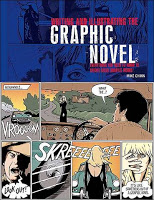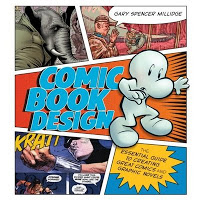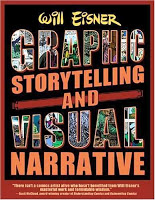 Reading a comic book or graphic novel requires levels of literacy, as the story is told through a combination of parts. Text can be a narrated exposition, a dialogue, it could be lost in a cluttered background or even onomatopoeic (a word’s meaning which originates in its associated sound…ka-boom!). Images convey meaning through shape, texture, line and colour, character and POV. Both text and image rely on a well-designed panel layout, which in turn implies time and space and motion.
Reading a comic book or graphic novel requires levels of literacy, as the story is told through a combination of parts. Text can be a narrated exposition, a dialogue, it could be lost in a cluttered background or even onomatopoeic (a word’s meaning which originates in its associated sound…ka-boom!). Images convey meaning through shape, texture, line and colour, character and POV. Both text and image rely on a well-designed panel layout, which in turn implies time and space and motion.
Many fans will recommend key titles to introduce novices to graphic novels. A great way to get people hooked is to give them the best stories. But I also suggest literary guides, because they can entice and educate and inspire.
I have in mind Understanding Comics: the invisible art and Making Comics: storytelling secrets of comics, manga and graphic novels, both by Scott McCloud. These are excellent first choices as they are themselves written in comic book format. A cartoon version of the author discusses everything from history, philosophy, and evolution of comic art, to techniques, styles and genres. Making Comics focuses on the practical concerns of creation, including marketing.
 In a similar vein, a dual-titled work by Prentis Rollins is an interesting opportunity. One side of the book is The Resonator, a sci-fi graphic novel. The other half, The Making of a Graphic Novel, uses the Resonator as a guide to explain the creative and technical processes involved. While the story isn’t stellar, the guide is insightful.
In a similar vein, a dual-titled work by Prentis Rollins is an interesting opportunity. One side of the book is The Resonator, a sci-fi graphic novel. The other half, The Making of a Graphic Novel, uses the Resonator as a guide to explain the creative and technical processes involved. While the story isn’t stellar, the guide is insightful.
For those interested in either writing or illustrating, try one of the following:
 Writing and Illustrating the Graphic Novel by Mike Chinn – The basics of comic book creation are discussed, separating scripting from sketching from publishing. The section on graphic novel genres is interesting, although it feels limited to only the popular ones.
Writing and Illustrating the Graphic Novel by Mike Chinn – The basics of comic book creation are discussed, separating scripting from sketching from publishing. The section on graphic novel genres is interesting, although it feels limited to only the popular ones.
The Insider’s Guide to Creating Comics and Graphic Novels by Andy Schmidt – Similar to Chinn’s book, this title also turns its focus to specific roles in publishing houses beyond author and artist, such as inking, colouring, and lettering. The creator profiles are also interesting for fans. The Everything Guide to Writing Graphic Novels: from superheroes to manga – all you need to create and sell your graphic works.
The Everything Guide to Writing Graphic Novels: from superheroes to manga – all you need to create and sell your graphic works.
by Mark and Melissa Ellis
The previous two books share much of the same insight as this title, but like all Everything Guides, the read is fast and easy without losing its instructive quality.
For a title with more focus, try one of these:
 Comic Book Design
Comic Book Design
by Gary Spencer Millidge
This title gives a step by step analysis of a graphic novel’s physical layout; how to design a panel, a page of panels, a character, a word balloon, and even the cover. The designer spotlights and variety of example pages are excellent, but I considered this title advanced compared to the previous mentions.
 Graphic Storytelling and Visual Narrative: principles and practices from the legendary cartoonist
Graphic Storytelling and Visual Narrative: principles and practices from the legendary cartoonist
by Will Eisner
Considered the first literary guide to creating graphic art and comics, this is probably the best introductory book and advanced technique book out there. Even Scott McCloud cites him as inspiration for his works. It is full of Eisner’s stories, each used as examples for his theories. Despite the intelligent and educated text, it is an easy and entertaining read.
And for writing like a pro, try:
 Writing for Comics with Peter David – A prolific writer of both genre and graphic novels, his expertise comes primarily from Marvel comics.
Writing for Comics with Peter David – A prolific writer of both genre and graphic novels, his expertise comes primarily from Marvel comics.
Alan Moore’s Writing for Comics – Also prolific and very opinionated, his reads more like a short treatise than a guide.
The DC Comics Guide to Writing Comics by Dennis O’Neil – This is a suitable pairing for Peter David’s book, as Marvel and DC dominate the comic book market.


